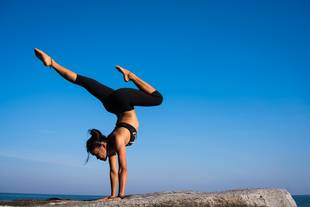
This peaceful practice will fire up your circulation and help you manage weight, stress, and blood sugars.
The benefits of yoga – including lowering blood pressure and easing back pain – should be enough to get anyone on the mat.
But while nearly 17 million U.S. women embrace their inner yogini, the numbers take a nosedive for those past age 44.
That’s unfortunate, experts say. “Yoga can be a lifelong best friend – if you know how to respect and listen to your body,” says Colleen Saidman Yee of Yoga Shanti studios in New York.
“Yoga will keep your joints and muscles fluid and flexible, and aid digestion and sleep,” she says.
Yoga can also have a positive effect on mental health, says John Zrebiec, M.S.W., CDE, director of Behavioral Health Services at the Joslin Diabetes Center in Boston. “Studies indicate a variety of beneficial outcomes,” Zrebiec says. Yoga may reduce stress, improve mood, increase self-confidence, enhance quality of life, strengthen cognitive function, and boost energy levels. Yoga may even reduce some symptoms of post-traumatic stress disorder.
Our recommendation: Just start practicing.
Look for a beginner’s DVD or class. “Then show up,” says Saidman Yee. “Chances are you’ll get away more than you expected.”
Read on for everything you need to know, whether you’re a first-timer or a regular wanting to learn more.
YOGA STYLES
“Yoga can be a lifelong best friend – if you know how to respect and listen and your body.” Seeking enlightenment? Or is fast and sweaty more your MO?
“Fortunately, yoga isn’t a one-size-fits-all exercise,” says Kristin McGee, a New York City-based yoga instructor. “There’s a type to suit every body and personality.”
Here are some styles to try.
Best for Beginners: Hatha, Iyengar
Though it’s the foundation for most types of modern yoga, Hatha has come to refer to a slow-paced style based on classic poses (asanas) and basic breathwork.
“Because it’s straightforward and unhurried, Hatha is an excellent pick for beginners,” McGee says.
For newbies interested in anatomy and proper form, she recommends Iyengar yoga. “It puts a heavy emphasis on alignment, using props like blocks, blankets, and bolsters to ease you into the positions.”
Best for Strength Training and Weight Loss: Ashtanga, Vinyasa Flow, Power Yoga
If your gym offers one of these Vinyasa-style classes, prepare for a rigorous workout. Designed to generate heat in the body through constant movement, these fast, flowing styles lead you through a series of asanas, linking each with an inhale and exhale.
“Challenging poses such as chaturangas (narrow-arm push-ups), repeated sun salutations, and difficult balance postures and inversions recruit every muscle in the body, upping the calorie burn,” McGee says.
Traditional Ashtanga classes incorporate chanting and meditation, while the Westernized Power Yoga sessions focus more on athleticism.
Best for Chilling Out: Yin, Restorative
Yin yoga takes a more passive approach to stretching, allowing your body to relax into poses rather than power through them.
“Holding postures for a longer period of time as you pay attention to your breath allows you to quiet your mind,” McGee says.
Restorative yoga is similarly gentle and calming, minus the focus on flexibility. Impatient people should steer clear; supported with bolsters and props, the poses may be held up to 20 minutes.
Best for Injury Rehab: Viniyoga
“This therapeutic practice is ideal for rehabilitation and healing because it’s tailored to each person’s specific needs,” McGee says.
Expect plenty of one-on-one time with a highly trained instructor who will modify the asanas to any physical limitations you have, whether you’re recovering from a sports-related sprain of soft-tissue injury or suffering from chronic low-back pain such as sciatica.
Best for Enhancing Energy: Kundalini
Meditative and spiritual, this branch of yoga teams fluid movements with visualization and breathing exercises, such as the alternate nostril method (using your thumb or ring finger to block one nostril as you inhale or exhale through the other).
“The aim is to release blocked energy from the base of your spine,” McGee says, “so it’s great for fighting fatigue and even for improving your sex life.”
Best for Self-Awareness: Anusara
Combine Iyengar’s emphasis on alignment with self-helpy language and you have Anusara yoga. The slower pace leaves ample time for deep thoughts and soul-searching.
“It’s all about heart opening and leading with grace,” McGee says. “It definitely has some modern spiritual elements and is quite lovey-dovey.”
YOGA SPEAK
Mantra: A few words or syllables to repeat while meditating, either silently or aloud. It’s meant to inspire and keep the mind from wandering – similar to an affirmation.
Namaste:(NAH-meh-stay) Much like aloha in Hawaiian culture, this word has come to have many meaning, including hello, good-bye, and thank you.
Om: A sound meant to signify the hum of the universe; it’s a chanting staple.
Savasana:(aka corpse pose) A deep relaxation pose in which your body is completely free of tension, which allows all the benefits of the yoga to take effect.
Sitz bones: Your instructor will say “sit on your sitz bones,” which means to support yourself by connecting with the two bony protrusions in your butt.
Sun salutation: A sequence of asanas (classic poses), including mountain pose, standing forward bend, lunge, plank pose, chaturanga, upward-facing dog, and downward-facing dog.
Tadasana:(tah-DAHS-anna) Also known as mountain pose, this is the starting position for all standing poses. Stand with your feet parallel and as close together as is comfortable. Firm your thigh muscles, lift the top of your head toward the ceiling, and hang your arms by your side.


















